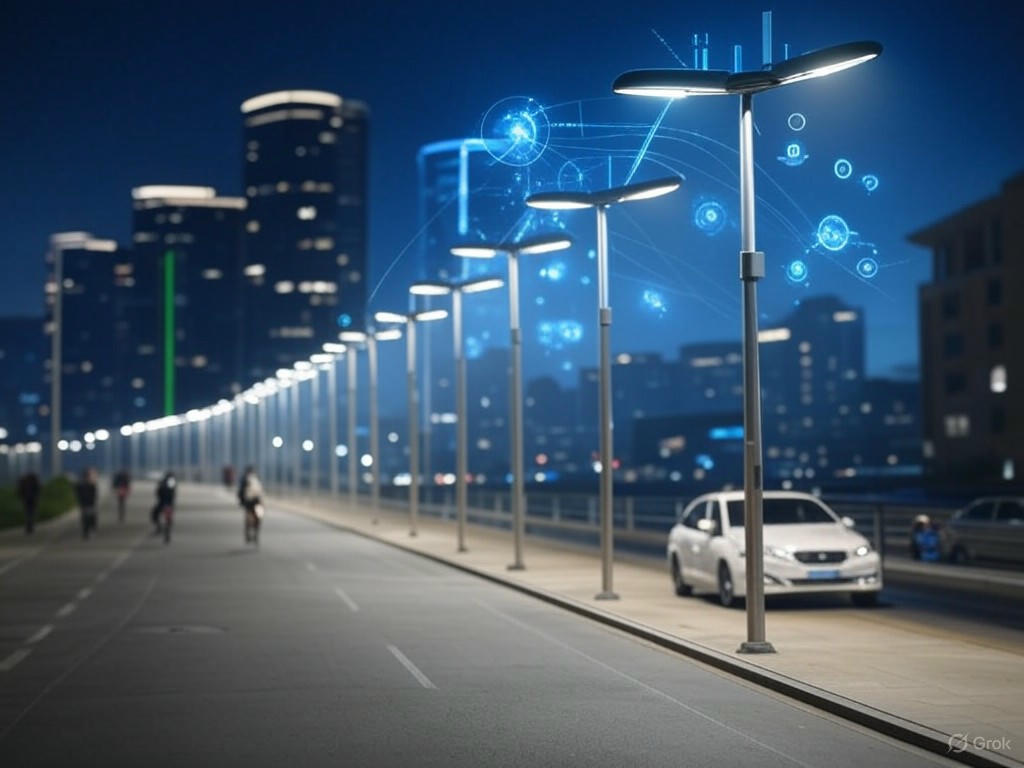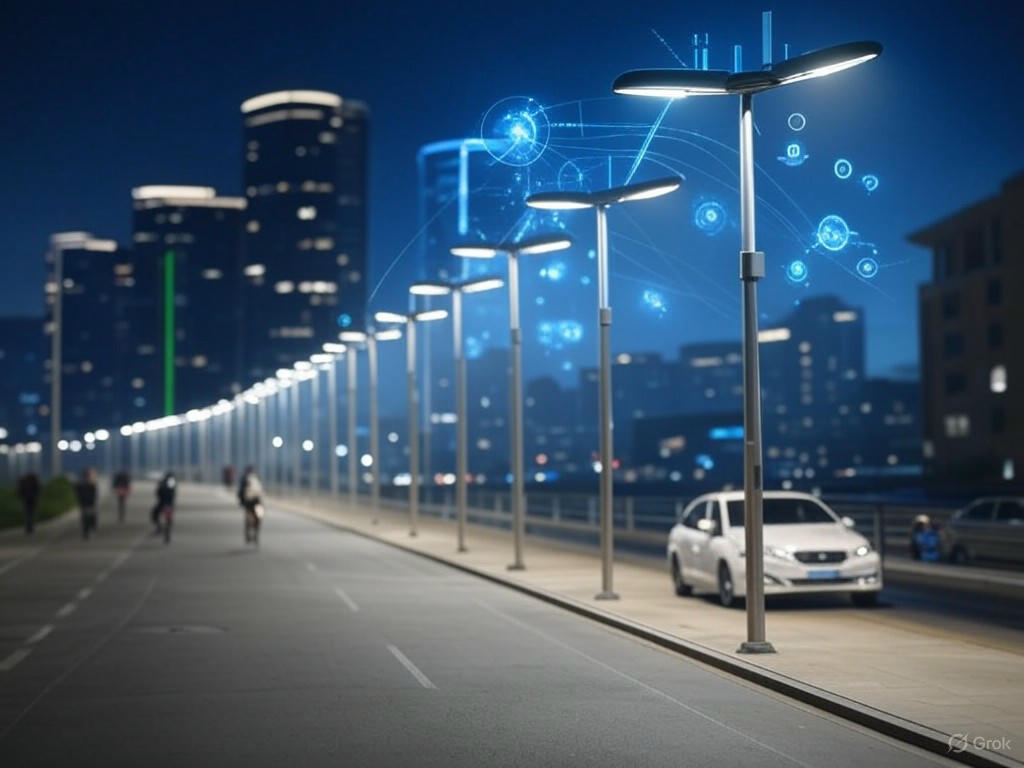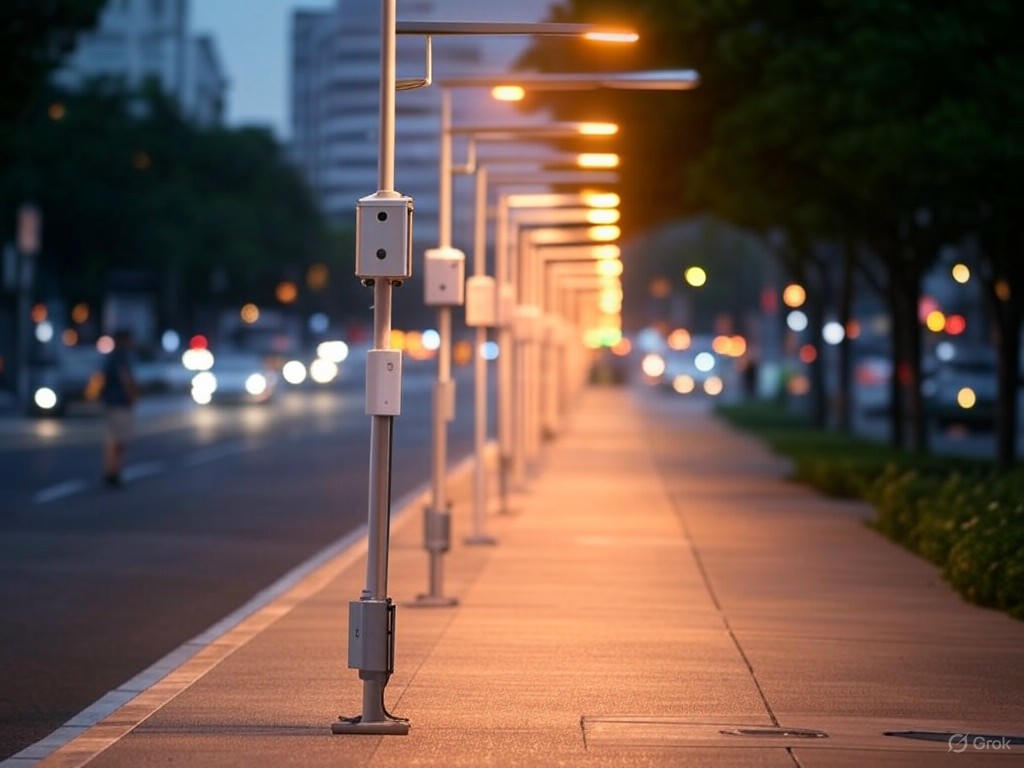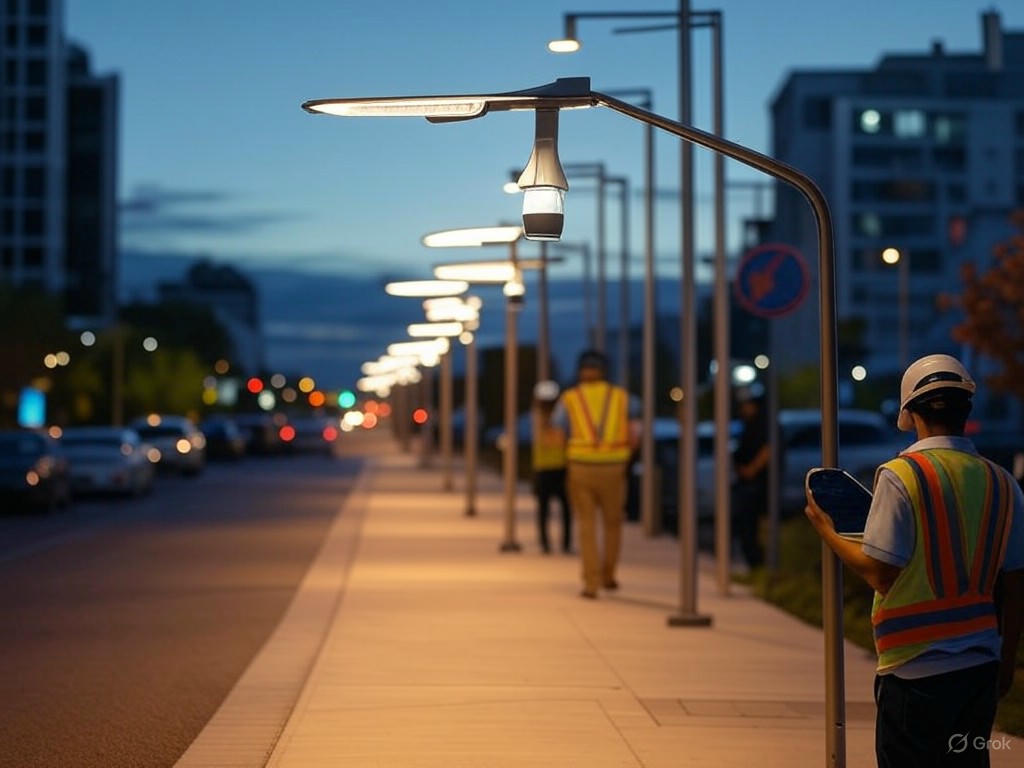
Smart Streetlight IoT Platforms Compared: Real-World Insights & Performance
- Introduction: Why Smart Streetlight Management Systems Matter in Smart Cities
- Energy Efficiency and Sustainability: Concrete Results
- Safety and Operational Cost Reduction: Demonstrated Impact
- Smart Streetlights as Urban IoT Platforms: Multipurpose Infrastructure
- Market Penetration: Rapid Acceleration, Not Peak
- IoT Platforms: The Digital Backbone of Intelligent Lighting
- Operational Barriers: Integration, Security, and Upfront Investment
- What This Analysis Delivers
- Core Technologies and Architectures: How IoT Powers Smart Streetlighting
- Smart City Streetlight Management: Beyond Basic Timers and Switches
- Sensor Types: From Simple Switching to Real-Time Urban Intelligence
- Communication Protocols: LoRa, ZigBee, LTE, 5G—Matching Technology to the Urban Landscape
- Network Topologies: Centralized, Decentralized, and Hybrid Models in Practice
- Integration with City Management Systems: The Persistent Bottleneck
- Technical Requirements: Latency, Throughput, Security, and Maintenance in the Real World
- Operational Implications: What These Choices Mean for Cities
- Comparative Analysis: Leading IoT Platforms for Smart Streetlight Management
- Market Share and Adoption: Who’s Actually in Use?
- Technical Capabilities and Integration Flexibility: Beyond the Spec Sheet
- Scalability: From Pilot Corridors to Citywide Rollouts
- Security, Vendor Lock-In, and User Feedback
- Use Cases and Performance Metrics: What’s Proven, What’s Hype
- Limitations and Innovations
- Bottom Line
- Real-World Performance and User Experience: From Installation to Everyday Operation
- Installation and Interoperability: Progress, but No Silver Bullet
- Operational Management and Maintenance: Tangible Gains, New Skill Demands
- User-Centric Features and Everyday Experience: Innovations (and Friction) in Practice
- Pain Points and Limitations: Integration, Security, and Lifecycle Costs Remain Stubborn Obstacles
- Quantifiable Outcomes: What the Numbers Show
- Bottom Line
- Future Outlook: Innovations, Limitations, and the Road Ahead for Smart Streetlight IoT Platforms
- Future Outlook: Innovations, Limitations, and the Road Ahead for Smart Streetlight IoT Platforms
- Innovations: Where Real Value Is Emerging
- Current Limitations: No Silver Bullets Yet
- The Road Ahead: Practical Recommendations and Outlook

Introduction: Why Smart Streetlight Management Systems Matter in Smart Cities
Smart Streetlight Management Systems: From Concept to Necessity
Smart streetlight management systems have moved from futuristic concept to operational necessity as cities face intensifying pressures around energy consumption, public safety, and sustainability. With over 300 million streetlights in operation worldwide, traditional lighting can account for up to 40% of a municipality’s electricity use—making it one of the largest contributors to both urban energy budgets and carbon emissions (Lighting Industry Overview, Sources 3, 4). This is not only a financial strain but also a missed opportunity to modernize urban infrastructure for measurable gains.
Energy Efficiency and Sustainability: Concrete Results
The shift from legacy lamps to LED-based smart systems is already producing quantifiable outcomes. For example, Philadelphia’s retrofit project—replacing 130,000 fixtures with networked LEDs—cut streetlighting energy use by more than 50% and reduced municipal carbon emissions by over 9% in a single deployment (Source 11). Globally, the adoption of smart streetlighting is projected to eliminate as much as 1.4 billion tons of CO₂ emissions by 2025 (Lighting Industry Overview, Source 0).
But LEDs are just the starting point. Adaptive dimming, motion detection, and time-based controls are further driving efficiency, slashing unnecessary energy use by an additional 30–50% (Lighting Industry Overview, Source 0). Düsseldorf’s “luminaire-by-luminaire” deployment enables granular, real-time control—delivering light precisely where and when needed, and minimizing both wasted energy and light pollution. These practical innovations translate into direct cost savings, improved resident satisfaction, and reduced ecological impact (Sources 2, 4).
Safety and Operational Cost Reduction: Demonstrated Impact
The benefits of smart streetlighting extend far beyond energy savings. Cities including Paris, Chicago, and Singapore have demonstrated that better-lit, dynamically managed public spaces correlate with reduced crime rates and safer roadways (Source 1). Intelligent systems, equipped with environmental and traffic sensors, enable lighting to respond to real-time conditions—boosting illumination for emergency situations or peak pedestrian and vehicle flow.
Operationally, remote monitoring and predictive maintenance represent a step change for city management. Instead of relying on citizen-reported outages, networked lighting controllers now detect and often resolve faults proactively—minimizing downtime and reducing maintenance costs by up to 50%. Advanced platforms, like those deployed by Ubicquia, provide meter-grade billing data and enable time-of-use tariffs, creating transparency and unlocking direct savings for both utilities and municipalities (DISTRIBUTECH, Source 8).
Smart Streetlights as Urban IoT Platforms: Multipurpose Infrastructure
Streetlights’ ubiquity and elevation make them ideal hubs for urban IoT sensors. Forward-looking cities are leveraging this infrastructure to deploy air quality monitors, acoustic sensors, and weather stations—transforming each pole into a data-gathering node. This approach, seen in real-world deployments from Paris to Surat, India, supports broader smart city functions such as traffic management, parking optimization, and public safety surveillance (Lighting Industry Overview, RT Insights, Sources 0, 9). Critically, this multiplies the value of existing networks without the cost and disruption of building standalone sensor grids, turning smart lighting into the backbone of a city’s digital ecosystem.
Market Penetration: Rapid Acceleration, Not Peak
The market for smart streetlights is expanding rapidly. By 2025, approximately 45% of new outdoor lighting projects will integrate IoT sensors (Lighting Industry Overview, Source 0), and the global installed base is on track to reach nearly 49 million units—up from 16 million just five years ago (Source 3). Europe leads with 35% of the global installed base, but adoption in North America and Asia-Pacific is accelerating quickly; China, Japan, and India now represent 65% of Asia’s deployments (Market Trends, Source 1).
Investment is far from plateauing: the global connected streetlights market is projected to grow from $0.6 billion in 2025 to over $3 billion by 2033, reflecting a CAGR above 22% (Market Trends, Source 1). Around 68% of urban centers now prioritize connected streetlighting in their modernization strategies, making this one of the most active segments in smart city infrastructure.
IoT Platforms: The Digital Backbone of Intelligent Lighting
The transformative potential of smart streetlighting hinges on robust IoT platforms. These platforms integrate sensors, controllers, and management software—enabling cities to collect real-time data, automate responses (such as adaptive dimming), and support predictive maintenance from a unified dashboard (Lighting Industry Overview, Sources 0, 2). When cities deploy leading platforms—whether commercial solutions like Microsoft Azure IoT, AWS IoT Core, Cisco IoT, or open-source alternatives such as ThingsBoard or Kaa—they consistently report increased reliability, reduced operational costs, and actionable insights that extend beyond lighting management.
These platforms also support advanced features such as open APIs, multi-sensor integration, and data analytics, allowing streetlighting infrastructure to serve as a foundation for broader smart city applications—from public safety to environmental monitoring and citizen engagement apps.
Operational Barriers: Integration, Security, and Upfront Investment
Despite the clear benefits, challenges remain. Integrating new systems with legacy infrastructure—including proprietary city management platforms and older cabling—can be complex and costly. Upfront investment is significant, especially for cash-strapped municipalities, though lighting-as-a-service models and public-private partnerships are helping to spread costs. Security and privacy concerns are also real; as more sensors and data streams come online, vulnerabilities must be managed proactively (Sources 9, 10). However, as deployment scales and open standards mature, integration costs and technical hurdles are trending downward.
What This Analysis Delivers
This article moves beyond vendor marketing and theoretical advantages to directly compare leading IoT platforms for smart streetlight management on the metrics that matter: real-world field performance, ease of integration, scalability, data analytics, and cost-effectiveness. The focus is on measurable outcomes—energy and cost savings, safety improvements, sustainability gains—based on current deployments, not vendor claims.
In summary, smart streetlight management is no longer just about illumination—it is about building a secure, interoperable digital backbone for the future city. With the right IoT platform, that backbone is already transforming urban environments worldwide.
| Benefit Area | Key Insights & Statistics |
|---|---|
| Energy Efficiency | LED retrofits and smart controls can reduce streetlighting energy use by 50%+ (e.g., Philadelphia project). Adaptive dimming and sensors save an additional 30–50%. |
| Sustainability | Global smart streetlighting could eliminate up to 1.4 billion tons of CO₂ by 2025. Philadelphia reduced municipal emissions by 9% with retrofit. |
| Safety | Improved lighting and dynamic management correlate with lower crime and safer roadways (as seen in Paris, Chicago, Singapore). |
| Operational Cost | Remote monitoring and predictive maintenance reduce maintenance costs by up to 50% and minimize downtime. |
| IoT Integration | Streetlights serve as hubs for sensors (air quality, weather, acoustic), supporting broader smart city applications (traffic, parking, surveillance). |
| Market Trends | Global installed base to reach 49 million by 2025 (up from 16 million five years ago). Market value projected to grow from $0.6B (2025) to $3B (2033). |
| Challenges | Integration with legacy systems, upfront investment, and security/privacy concerns remain key barriers. |
Core Technologies and Architectures: How IoT Powers Smart Streetlighting

Smart City Streetlight Management: Beyond Basic Timers and Switches
Smart city streetlight management has evolved well beyond basic timers or manual switches. Today’s deployments are anchored by layered IoT architectures that blend advanced sensors, resilient communications, and centralized management platforms. For cities, the choices made at this foundational level directly determine savings, safety, and the ability to scale smart city initiatives. Here, the technical realities—not marketing promises—define success.
Sensor Types: From Simple Switching to Real-Time Urban Intelligence
The leap forward in smart streetlighting is not just remote control—it’s the breadth and intelligence of sensors embedded in each pole. High-end platforms now routinely include motion detectors, ambient light sensors, and environmental modules measuring air quality, noise, and weather. Cities like Paris and Surat, India have turned streetlight poles into data-rich nodes, supporting applications such as adaptive lighting, environmental monitoring, and even traffic analytics.
A modern streetlight may, for example, dim to 30% output when no motion is detected, then instantly ramp up brightness for a passing cyclist—all while logging particulate levels and temperature. This approach, seen in Barcelona and Düsseldorf, can reduce energy use by up to 70% compared to legacy systems. More importantly, it powers predictive maintenance: systems flag dimming bulbs, power fluctuations, or connectivity issues before they escalate, slashing breakdowns by as much as 70% and reducing downtime by up to 45%.
Communication Protocols: LoRa, ZigBee, LTE, 5G—Matching Technology to the Urban Landscape
Selecting the right communication backbone is a nuanced trade-off between range, bandwidth, cost, and interference. LoRa (Long Range) and ZigBee are the most common wireless protocols for connecting large streetlight fleets, but real-world deployments often blend them with LTE/5G to balance cost and capability:
- LoRa: Offers city-wide reach with ultra-low power consumption. LoRaWAN networks can span up to 20 kilometers—an advantage for cities with sprawling suburbs or where trenching new cables is costly. Data rates are modest (300 bps to 37.5 kbps), but are sufficient for sensor readings and control signals. Paris and Washington, D.C. deployments using inteliLIGHT® demonstrate LoRa’s real-world effectiveness for open, interoperable systems.
- ZigBee: Provides higher throughput (up to 250 kbps) but is best suited for dense urban blocks where lights are close together. ZigBee’s mesh topology enables redundancy, but signal reliability can be challenged by radio noise or metal-heavy environments—common in older city centers.
- LTE/5G: For high-bandwidth needs—such as video surveillance or public Wi-Fi integrated with streetlights—cellular networks provide robust, low-latency connectivity. The trade-off is higher power draw and recurring data costs. Hybrid models are now common: routine lighting control and sensor data use LoRa or ZigBee, while LTE/5G is reserved for firmware updates or video feeds, as seen in Singapore’s 5G-enabled upgrades.
There is no one-size-fits-all answer. Cities with mixed infrastructure—historic cores, industrial zones, new developments—often deploy multiple protocols, optimizing for local density, interference, and cost.
Network Topologies: Centralized, Decentralized, and Hybrid Models in Practice
The architecture of a streetlight management system—centralized, decentralized, or hybrid—shapes its resilience, efficiency, and integration ease:
- Centralized Systems: All data flows to a single command center. This streamlines operations and enables city-wide analytics; for example, Los Angeles and Amsterdam report faster outage resolution and energy savings after adopting centralized, cloud-based dashboards. However, centralized models introduce a single point of failure, making robust backup and cybersecurity essential.
- Decentralized/Distributed Systems: Each node or cluster can make localized decisions, a model growing in popularity with blockchain/Web3-enabled pilots. This enhances resilience—if one node fails, the rest remain functional—but can complicate data synchronization and city-wide reporting.
- Hybrid Approaches: The most adaptable deployments (and the dominant trend in both North America and Europe) combine local autonomy for core lighting and safety functions with central aggregation for analytics and reporting. Miami’s recent retrofit and Paris’s adaptive lighting are both examples where local control is balanced with central oversight, supporting both resilience and advanced features.
Field experience consistently shows that hybrid models deliver the best trade-off between operational uptime and actionable analytics.
Integration with City Management Systems: The Persistent Bottleneck
On paper, connecting streetlights to city dashboards seems straightforward. In reality, integration with legacy city management infrastructure is the single greatest technical hurdle. Many cities still operate proprietary or siloed systems for energy, traffic, or public safety, making real-time data exchange challenging.
Platforms that support open APIs and standardized data protocols (MQTT, OPC UA, RESTful web services) have a clear advantage, reducing costly middleware and minimizing data silos. Cities like Montréal and Columbus, OH, realized major savings only after choosing platforms with proven interoperability—while European municipalities adopting open-source stacks found that, despite initial technical overhead, long-term flexibility was improved. As of 2025, ISO/IEC 27701 privacy compliance is now required in over two-thirds of European smart city RFPs, making true standards alignment a prerequisite.
Technical Requirements: Latency, Throughput, Security, and Maintenance in the Real World
- Latency: For basic lighting control, a 1–3 second delay is tolerable. But for safety-critical functions—such as crosswalk illumination triggered by motion or emergency events—sub-500ms latency is essential. LoRa may struggle with latency-sensitive tasks, while LTE/5G and wired connections excel.
- Data Throughput: Most streetlight sensors transmit very small data packets, but adding video analytics or Wi-Fi requires megabit-per-second bandwidth. Cities should future-proof: what works for dimming today may fall short if camera feeds or EV charging are added tomorrow.
- Security: With smart streetlights becoming part of critical city infrastructure, neglecting device security is no longer an option. Systems must support strong encryption (TLS, AES-256), regular over-the-air updates, and network segmentation. Field audits repeatedly expose systems still running with default passwords or outdated firmware—significant vulnerabilities that have led to outages and, in some cases, breaches.
- Maintenance: Predictive analytics is delivering on its promise, with cities reporting up to 45% less downtime and 70% fewer unplanned breakdowns after IoT upgrades. Proactive outage detection (>95% accuracy in leading deployments) and remote diagnostics are now baseline expectations, not premium features.
Operational Implications: What These Choices Mean for Cities
The technical backbone of IoT-powered streetlighting is complex, but the operational payoff is clear: actionable data, measurable energy savings, and improved safety. The most successful deployments share three traits: interoperability, robust security, and future-ready architectures. Pilot corridors—in Philadelphia, Miami, or Surat—demonstrate that getting these fundamentals right leads to scalable, resilient, and cost-effective smart city infrastructure.
In summary, the technologies and architectures powering smart streetlighting are not abstract choices—they are the foundation for urban digital transformation. Cities that prioritize open standards, hybrid resilience, and real-world security are already realizing the benefits: lower costs, safer streets, and a smarter urban future.
| Aspect | Key Options/Technologies | Real-World Examples | Operational Impact |
|---|---|---|---|
| Sensor Types | Motion, ambient light, air quality, noise, weather | Paris, Surat, Barcelona, Düsseldorf | Up to 70% energy savings, predictive maintenance, improved safety |
| Communication Protocols | LoRa, ZigBee, LTE/5G (often hybrid) | Paris (LoRa), DC (LoRa), Singapore (5G), Hybrid models common | Trade-offs between range, bandwidth, cost, and latency |
| Network Topology | Centralized, Decentralized, Hybrid | LA, Amsterdam (Centralized); Miami, Paris (Hybrid) | Hybrid delivers best uptime and analytics, resilience vs. single point of failure |
| Integration & Interoperability | Open APIs, Standardized protocols (MQTT, OPC UA, RESTful), ISO/IEC 27701 compliance | Montréal, Columbus, European cities with open-source stacks | Reduced silos, cost savings, future-proofing |
| Technical Requirements | Latency (sub-500ms for safety), Throughput, Security (TLS, AES-256), Predictive maintenance | Field audits, Leading deployments (>95% outage detection accuracy) | Lower downtime, fewer breakdowns, improved security, future scalability |
Comparative Analysis: Leading IoT Platforms for Smart Streetlight Management

Choosing an IoT Platform for Smart Streetlight Management
Choosing an IoT platform for smart streetlight management is more than a technical procurement—it’s a strategic decision with operational, financial, and long-term security repercussions. As the smart lighting market accelerates—projected to jump from $27.33 billion in 2024 to nearly $175 billion by 2033—cities and utilities must navigate a fragmented landscape of commercial and open-source platforms, each with distinct strengths, risks, and deployment realities. Below is a comparative, evidence-based analysis of leading IoT platforms powering smart streetlight systems, grounded in real-world deployments, measurable outcomes, and direct user feedback.
Market Share and Adoption: Who’s Actually in Use?
Adoption patterns reveal which platforms have proven themselves at city scale. As of 2025, Microsoft Azure IoT leads the smart city market with 17% share, followed by AWS IoT Core (15%), Cisco IoT (14%), IBM Watson IoT (11%), and Google Cloud IoT (10%). For streetlight-specific deployments, Google Cloud IoT, Siemens MindSphere, Huawei OceanConnect, and Bosch IoT Suite are the most commonly cited commercial choices, while open-source options like Kaa and ThingsBoard together comprise about 2% of smart city projects—typically where budgets are constrained or bespoke integration is required.
Geographic trends are clear: Huawei OceanConnect dominates new deployments in Asia (5% of projects), Bosch IoT Suite has a stronghold in Europe (3%), and open-source stacks cluster in cities seeking maximum flexibility or cost control, often in conjunction with local technical teams. LoRa-based and LPWAN platforms, such as inteliLIGHT® (deployed in Paris and Washington, D.C.), now account for over 10% of smart city sensor networks, especially where wide-area, low-power connectivity is essential (as in Paris and Singapore).
Technical Capabilities and Integration Flexibility: Beyond the Spec Sheet
Commercial platforms differentiate themselves on scalability, analytics, and out-of-the-box AI/ML integration. Google Cloud IoT, for example, enables “serverless, AI-powered, and highly scalable” management, supporting millions of devices with real-time analytics, predictive maintenance, and automated anomaly detection. Siemens MindSphere stands out for its digital twin capabilities and advanced visualization—key for large urban deployments where geospatial context is critical (see Düsseldorf’s luminaire-level control).
Huawei OceanConnect is engineered for holistic, multi-vendor integration, supporting cities where legacy infrastructure and new IoT nodes must coexist. Bosch IoT Suite, while smaller in global share, is widely used in European projects due to modularity and robust support for both cloud and edge deployments—essential for cities with strict data residency or privacy mandates.
Open-source platforms like Kaa and ThingsBoard prioritize flexibility over polish. They empower cities to avoid proprietary lock-in and tailor solutions, but typically require greater in-house expertise. These platforms often lack the mature analytics dashboards, automated outage detection, and citizen engagement apps seen in commercial cloud offerings, as highlighted by European municipalities that chose open-source stacks to avoid recurring licensing costs but faced steeper technical learning curves.
Integration flexibility is a growing differentiator. Commercial vendors have responded to demand for open APIs and data sovereignty (notably in Europe, where 68% of smart city RFPs now require ISO/IEC 27701 privacy compliance and localized data handling) by modularizing their architectures and supporting local processing via edge nodes. Multi-protocol support—including MQTT, LoRaWAN, NB-IoT, and RESTful APIs—is now table stakes for serious contenders.
Scalability: From Pilot Corridors to Citywide Rollouts
Scalability is non-negotiable for urban deployments. Google Cloud IoT and AWS IoT Core are validated in citywide rollouts—such as Philadelphia’s 130,000-fixture LED retrofit—handling millions of devices, with edge computing integrations to minimize latency and data costs. Siemens MindSphere and Huawei OceanConnect offer robust scaling, but user feedback indicates that integrating legacy SCADA or proprietary protocols often requires careful planning and, in some cases, third-party middleware to avoid bottlenecks.
Open-source solutions can scale—with Surat, India, as a standout case using edge AI cameras and sensors across thousands of poles—but require significant customization and sustained technical oversight. Multi-platform, hybrid deployments (now present in about 5% of new projects) are increasing, particularly in cities that treat vendor lock-in as a strategic risk. However, operational complexity rises with each additional platform.
Security, Vendor Lock-In, and User Feedback
Security is paramount as cities digitize critical infrastructure. All leading commercial platforms—Google Cloud, AWS, Azure—offer enterprise-grade security: data encrypted at rest and in transit (TLS, AES-256), granular device authentication, automated patching, and regular third-party audits. Siemens and Cisco are investing in modular security frameworks to comply with stricter European privacy laws, which increasingly dictate platform selection.
Vendor lock-in remains the most persistent pain point in user feedback. Commercial stacks deliver rapid deployment and polished dashboards, but cities risk being tethered to proprietary protocols, data silos, and inflexible pricing. This drives adoption of open-source or multi-platform approaches, particularly in Europe and Asia—Paris and Singapore have both championed open standards and interoperability to future-proof investments.
Real-world feedback is instructive. Columbus, OH, and Montréal, QC, each report multimillion-dollar annual savings and operational efficiency gains after adopting commercial cloud platforms—Columbus cites $3.7 million in annual savings. In contrast, European municipalities using open-source stacks praise the elimination of licensing costs and increased control, but acknowledge that in-house technical demands are higher and integration with citizen engagement apps or predictive analytics requires more upfront effort.
Use Cases and Performance Metrics: What’s Proven, What’s Hype
Platform-agnostic data confirms that smart streetlight systems, when properly deployed, deliver substantial energy and maintenance savings: up to 50% per light, with $15 billion in global cumulative savings projected by 2023. Predictive maintenance powered by IoT analytics has reduced downtime by up to 45% and cut unplanned breakdowns by 70% in leading deployments (e.g., Los Angeles, Amsterdam, Barcelona).
Advanced, real-world use cases are now routine. Barcelona dynamically adjusts streetlight brightness based on pedestrian activity, cutting energy use by 30%. North American cities leverage integrated dashboards to manage lighting, signage, and public safety alerts from a single interface. Surat, India, overlays traffic, air quality, and safety monitoring via edge AI on its lighting network, enabling real-time interventions.
Limitations and Innovations
No platform is perfect. Commercial solutions can be expensive and, over time, may constrain flexibility. Open-source stacks require deeper internal expertise and ongoing maintenance. Integration with legacy SCADA or proprietary systems is a recurring headache—data silos and lack of interoperability remain operational bottlenecks. Security oversights—such as default passwords or unpatched firmware—are still reported, especially in rapid, large-scale rollouts.
Yet innovation is moving fast. LPWAN and LoRa-based platforms are enabling deployments in areas with weak connectivity. Edge computing is reducing dependence on continuous cloud access, and modular architectures are easing future upgrades and vendor transitions. Open standards—championed in Paris and supported by platforms like inteliLIGHT®—are proving to be the most effective defense against long-term lock-in.
Bottom Line
For most cities, the optimal platform balances short-term ease of deployment with long-term flexibility and control. Google Cloud IoT and Siemens MindSphere offer best-in-class analytics, scalability, and security, but come with higher lock-in risk. Huawei OceanConnect and Bosch IoT Suite excel in regional deployments and multi-vendor integration, favored where data residency and interoperability are critical. Open-source platforms are a strong fit for cities with unique requirements and robust technical teams, but demand a greater operational commitment.
The evidence is clear: Smart streetlight management systems, when matched with the right IoT platform, deliver measurable energy savings, operational efficiency, and safety improvements. Platform choice will shape a city’s digital backbone for years to come. Cities that prioritize open APIs, future expansion, and proactive vendor risk management are already realizing the greatest returns—while those that chase marketing hype over operational metrics often pay more, and get less, in the long run.
| Platform | Market Share / Adoption | Key Strengths | Integration Flexibility | Scalability | Security | Vendor Lock-In Risk | Notable Deployments / Regions |
|---|---|---|---|---|---|---|---|
| Google Cloud IoT | 10% (Smart City Market); Common in streetlight deployments | Serverless, highly scalable; Advanced analytics; Predictive maintenance; Automated anomaly detection | Open APIs, modular architecture; Multi-protocol (MQTT, LoRaWAN, NB-IoT, RESTful APIs) | Proven citywide rollouts (millions of devices) | Enterprise-grade (TLS, AES-256, regular audits) | High | North America, Europe; Los Angeles, Barcelona |
| Microsoft Azure IoT | 17% (Smart City Market leader) | Scalability; Integration with Microsoft ecosystem; Strong analytics | Supports open APIs, multi-protocol | City-scale deployments | Enterprise-grade | High | Global |
| AWS IoT Core | 15% (Smart City Market) | Scalability; Edge computing integrations; Real-time analytics | Multi-protocol; Open APIs | Proven citywide (e.g., Philadelphia 130,000-fixture rollout) | Enterprise-grade | High | North America |
| Siemens MindSphere | Not specified (Strong in Europe) | Digital twin; Advanced visualization; Modular security | Supports legacy SCADA, multi-vendor integration | Robust; Large urban rollouts | Modular, privacy-focused (EU compliance) | Moderate | Europe (Düsseldorf, Amsterdam) |
| Huawei OceanConnect | 5% of new Asian projects | Holistic, multi-vendor integration; Data residency | Strong legacy integration; Modular | Robust, but integration planning needed | Enterprise-grade | Moderate | Asia (Singapore, China) |
| Bosch IoT Suite | 3% (Europe) | Modularity; Cloud & edge support; Data privacy | Flexible, supports edge deployments | Regional city rollouts | Strong European compliance | Moderate | Europe (Germany, France) |
| Open Source (Kaa, ThingsBoard) | ~2% (Smart City Market) | Flexibility; No licensing costs; Customization | Maximum, but requires in-house expertise | Scalable (with effort); Custom/hybrid deployments | Depends on implementation | Low | India (Surat), budget-conscious cities, Europe (privacy-focused) |
| inteliLIGHT® (LPWAN/LoRa) | 10%+ of smart city sensor networks | Low-power, wide-area; Suitable for weak connectivity | Supports open standards, LoRaWAN | Wide-area deployments | Platform-dependent | Low | Paris, Washington D.C., Singapore |
Real-World Performance and User Experience: From Installation to Everyday Operation
Field Performance of Smart City Streetlight Management Systems
When evaluating smart city streetlight management systems, the real test isn’t in vendor brochures—it’s in how these platforms perform from installation through daily operation, and whether they actually deliver on promises of energy savings, reliability, and citizen value. Here is a pragmatic look at field performance, drawing on deployments in Miami, Paris, Singapore, and other cities leading the smart lighting transformation.
Installation and Interoperability: Progress, but No Silver Bullet
Key takeaway: Open standards and modular hardware are accelerating installation and integration, but legacy infrastructure and fragmented vendor ecosystems remain major pain points.
Miami’s recent large-scale retrofit exemplifies the new norm: cities now seek platforms offering lamp-level management and remote diagnostics, often deploying modular controllers that support open protocols like LoRaWAN and NB-IoT (see inteliLIGHT®, active in Paris and Washington, D.C.). This open-standards approach reduces vendor lock-in and enables integration with broader smart city systems—traffic control, environmental sensors, and public safety platforms—delivering real-time data across municipal domains.
Paris sets a clear precedent: interoperability is a non-negotiable requirement. Its planners demand that streetlight systems communicate seamlessly with traffic, air quality, and safety infrastructure, pushing vendors to support open APIs and standardized protocols (LoRaWAN, NB-IoT, MQTT). Meanwhile, Singapore benefits from strong central coordination, a government-driven 5G rollout, and uniform security standards. This top-down approach streamlines deployment and helps overcome integration and legacy system challenges that still bog down many North American and European cities.
Despite this progress, field deployments regularly encounter obstacles. Microchip’s European case study highlights how connecting streetlights across seven-mile stretches—often a mix of legacy and new hardware—demands careful planning around wireless range, interference, and power supply. Even in Singapore, integrating older assets adds complexity and costs, underscoring that full interoperability is still a work in progress.
Operational Management and Maintenance: Tangible Gains, New Skill Demands
Bottom line: Smart platforms deliver measurable energy and maintenance savings, but introduce new operational complexities and workforce requirements.
Traditional streetlighting can consume up to 40% of a city’s energy budget. Cities such as Los Angeles, Amsterdam, and Paris, after upgrading to LED-based, networked systems, have reported energy savings of 50–65%. Paris, for example, saves €9 million annually. With advanced features like adaptive dimming—automatically brightening when traffic or activity spikes, then dimming during off-peak hours—some cities are pushing energy savings as high as 80% compared to legacy sodium-vapor lamps.
On the maintenance front, the impact is equally pronounced. Real-time health monitoring and automated fault detection have enabled maintenance cost reductions of up to 50%. Outage detection accuracy now exceeds 95%, allowing cities to dispatch crews only when and where needed, eliminating wasteful “night patrols.” The addition of predictive analytics—leveraging continuous IoT monitoring—has cut downtime by up to 45% and reduced unplanned breakdowns by as much as 70%.
However, these gains don’t come without tradeoffs. Miami’s experience highlights a steep learning curve: staff must now manage device firmware, ensure data security, and troubleshoot network nodes, often requiring upskilling or outsourcing. These operational costs are frequently underestimated during procurement. In contrast, Singapore’s central funding and training programs mitigate these growing pains, but cities with fragmented IT resources or multi-vendor architectures face real challenges in day-to-day management.
User-Centric Features and Everyday Experience: Innovations (and Friction) in Practice
Real-world impact: Adaptive lighting, real-time alerts, and citizen engagement apps are moving from pilot to standard—but only in cities investing in integration and responsive operations.
Both Paris and Singapore have gone beyond energy efficiency, using environmental and traffic sensors to dynamically tune lighting for safety and ecological impact—reducing light pollution and minimizing disruption to human circadian rhythms and urban wildlife. Miami’s multi-use poles increasingly host additional sensors (air quality, noise, video), laying the groundwork for “urban nervous systems” that support broader smart city initiatives.
Citizen-facing features are also becoming mainstream. In pilot cities, more than half of residents regularly use mobile apps to report outages or check streetlight status. Platforms that integrate real-time IoT updates see up to 65% higher daily engagement. However, user satisfaction is tightly linked to operational responsiveness: if digital alerts don’t translate into fast fixes, public trust and app usage drop off quickly. This reinforces that technology alone is not enough—cities must also invest in process and field resources.
Pain Points and Limitations: Integration, Security, and Lifecycle Costs Remain Stubborn Obstacles
Reality check: While interoperability and security are improving, legacy systems, fragmented vendors, and unclear funding models still slow progress and inflate costs.
Despite more robust open standards, integration with legacy infrastructure remains costly and time-consuming. Security is an evolving challenge: as cities add more devices and citizen-facing apps, the attack surface grows, requiring ongoing updates, network segmentation, and regular audits. Both Miami and Paris report persistent confusion over long-term funding responsibilities—specifically, who pays for upgrades, cloud storage, and cybersecurity throughout a 10+ year lifecycle. True “plug-and-play” interoperability and transparent total cost of ownership are still out of reach for many municipalities.
Quantifiable Outcomes: What the Numbers Show
- Energy Savings: 50–80% reduction in energy use versus legacy systems; up to $30 per lamp per year in operational savings; Paris saves €9 million annually.
- Maintenance Reduction: Up to 50% lower costs; outage detection accuracy >95%; predictive analytics cut downtime by 45% and unplanned breakdowns by 70%.
- Failure Rates: Failure rates drop as much as 70% after full IoT deployment.
- Citizen Impact: Up to 15% reduction in street crime in cities with adaptive lighting; citizen engagement apps increase satisfaction and usage—but only when paired with swift field response.
Bottom Line
Smart streetlight management systems have moved well beyond pilot projects—they are delivering real, measurable returns in energy efficiency, operational cost reduction, and urban sustainability. The most successful cities—those seeing the highest savings and citizen satisfaction—are characterized by strong IT leadership, adoption of open standards, and a commitment to ongoing staff training. The latest platforms are modular, interoperable, and rich in features, but legacy integration challenges, skill gaps, and murky funding models continue to hinder progress for many municipalities. The best results are found where technology, people, and processes are upgraded in concert—proving that smart lighting is as much a management challenge as it is a technological one.
| Aspect | Key Insights | Metrics/Examples |
|---|---|---|
| Installation & Interoperability | Open standards and modular hardware enable faster deployment, but legacy systems and fragmented vendors cause challenges. | Miami (modular, open protocols), Paris (strict interoperability), Singapore (centralized rollout) |
| Operational Management & Maintenance | Significant energy and maintenance savings, but require new skills and resources. | Energy savings: 50–80%; Paris: €9M saved/year; Maintenance cost reduction up to 50%; Outage detection >95% |
| User-Centric Features | Adaptive lighting and citizen apps improve safety and engagement, but require responsive operations. | 65% higher app engagement with IoT integration; up to 15% crime reduction; app use drops if response is slow |
| Pain Points & Limitations | Integration, security, and funding remain obstacles despite progress in standards. | Legacy integration is costly; ongoing security needs; unclear funding for lifecycle costs |
| Quantifiable Outcomes | Energy, maintenance, and citizen impact metrics show strong gains where best practices are adopted. | Energy: 50–80% reduction; Maintenance: up to 50% lower costs; Failure rates down 70%; Downtime cut 45% |
Future Outlook: Innovations, Limitations, and the Road Ahead for Smart Streetlight IoT Platforms
Future Outlook: Innovations, Limitations, and the Road Ahead for Smart Streetlight IoT Platforms
The next decade will see smart streetlight IoT platforms move from pilot projects and energy-saving retrofits to foundational city infrastructure—provided cities and vendors address persistent real-world limitations even as new innovations accelerate. Field evidence from leading deployments in cities like Surat, Paris, and Miami, as well as market data, makes clear that platforms with true staying power blend technical sophistication with pragmatic, city-centric features and operational resilience.
Innovations: Where Real Value Is Emerging
The most significant leap is the rise of AI-driven analytics and edge computing at the streetlight node. In Surat, India, for example, edge AI cameras and multi-sensor modules on each streetlight go far beyond simple dimming schedules. These nodes now monitor traffic flow, air quality, and public safety, providing actionable data within single-digit milliseconds—enabling real-time traffic rerouting, instant adaptive lighting, and rapid incident response (see: Surat deployment, Paris adaptive lighting).
Edge computing is not just a buzzword; it dramatically reduces latency, supporting safety-critical functions such as adaptive dimming (where lights ramp up as a cyclist passes, then down again to save energy and reduce light pollution). The operational gains echo those seen in Paris and Barcelona, where environmental and traffic sensors dynamically tune lighting, resulting in energy savings of up to 80% compared to legacy lamps.
Platforms like Ubicquia now deliver meter-grade billing data and support time-of-use energy tariffs—letting cities align costs with actual usage. This is not theoretical: cities report municipal energy budget reductions of 30–50% after deploying smart controls and LEDs, with Los Angeles and Amsterdam documenting 50–65% energy savings post-upgrade.
Multi-sensor integration has shifted from niche to baseline for top-tier systems. Today’s smart streetlights function as urban IoT nodes—combining lighting with environmental monitoring, traffic management, and even Wi-Fi or 5G connectivity for public access. The best platforms offer modular hardware and open APIs, enabling cities to add features like video analytics, air quality monitoring, or EV charging as budgets and policy priorities evolve—mirroring practices in large-scale deployments across Europe and Asia.
Open data initiatives are also gathering momentum. By providing anonymized sensor data to planners, startups, and researchers, cities stimulate “open innovation” and third-party development. Surat’s Smart City Innovation Challenge exemplifies this trend, inviting developers to build apps for everything from pedestrian safety to pollution reduction, and echoing the integrated dashboards now standard in North American and European cities.
Current Limitations: No Silver Bullets Yet
Even as adoption accelerates, scaling these platforms city-wide is not frictionless. Scalability remains a challenge: mesh networking and edge computing help, but managing tens of thousands of distributed nodes introduces logistical and technical complexity. Device provisioning, firmware updates, and network health monitoring require robust, automated management tools—gaps in this area can lead to costly downtime and inefficiency, as seen in integration challenges documented by Microchip’s European case study and Miami’s retrofit.
Cybersecurity is the elephant in the room. As cities “hyper-connect” street infrastructure, the attack surface expands dramatically. A single exploited vulnerability could disrupt public lighting or compromise sensitive municipal data. Best-in-class platforms now include encrypted communications (AES-256), TLS, network segmentation, and automated incident response—but city IT teams need ongoing training and must budget for persistent security maintenance, reflecting lessons learned from recent breaches in critical infrastructure.
Interoperability and standardization are ongoing hurdles. Many legacy management systems and new IoT devices still use proprietary or incompatible standards, leading to expensive integration projects or vendor lock-in. Paris and inteliLIGHT® deployments demonstrate that open protocols (LoRaWAN, NB-IoT, open APIs) and modular hardware ease upgrades and avoid costly “rip-and-replace” cycles, but such openness is not yet universal.
Cost remains the biggest adoption barrier, especially for smaller municipalities or those with aging infrastructure. Upfront investments in hardware, network upgrades, and systems integration can take years to recoup—even with energy savings and maintenance reductions factored in. Some vendors now offer “lighting-as-a-service” models to shift capital expense to operating expense, but total cost of ownership—including ongoing cybersecurity, software updates, and system management—must be realistically modeled, as seen in analysis of European open-source pilots versus commercial cloud deployments in Columbus and Montréal.
The Road Ahead: Practical Recommendations and Outlook
For city planners and technology leaders, the most successful adoption strategies are incremental, modular, and evidence-based. Pilot corridors—such as those focused on high-traffic or high-crime areas—should be prioritized to deliver measurable benefits in energy use, uptime, or public safety. Cities like Philadelphia and Barcelona have used pilot results to refine requirements and secure stakeholder buy-in for broader rollouts.
When evaluating platforms, prioritize solutions that offer:
- Proven scalability: Management tools capable of handling thousands (or tens of thousands) of endpoints with minimal manual intervention.
- Open APIs and standards compliance: Ensure long-term interoperability and avoid vendor lock-in by requiring open protocols and modular hardware.
- Transparent, meter-grade billing: Real-time billing and usage data are essential for aligning costs and supporting municipal energy optimization.
- Ongoing security updates and training: Cyber threats evolve—plan for regular patching, security audits, and IT staff upskilling.
Budget not just for hardware but for integration, long-term maintenance, and iterative upgrades. Leverage public-private partnerships to share risk and costs, and open data streams to attract innovation and external funding as demonstrated by Surat’s Innovation Challenge and US/EU pilot cities.
Manage expectations: Smart streetlight IoT platforms are not a panacea for all urban challenges, but they are rapidly becoming indispensable for cities focused on safety, efficiency, and sustainability. The most successful deployments balance ambition with realism—testing rigorously, scaling thoughtfully, and keeping citizen outcomes at the center of every decision.
Key Takeaway:
Smart streetlight IoT platforms are graduating from isolated pilots to core city infrastructure—but only where technical rigor meets practical city management. The winners will be open, secure, scalable, and relentlessly focused on real-world impact, not just technical possibility. Cities that approach adoption incrementally, with clear requirements and a focus on operational results, will be best positioned to realize the full promise of next-generation streetlight management.
| Aspect | Innovations | Current Limitations | Road Ahead / Recommendations |
|---|---|---|---|
| Technical Advances | AI-driven analytics, edge computing, adaptive dimming, multi-sensor modules, open APIs | Scalability challenges, interoperability issues, integration complexity | Prioritize scalable, open, modular platforms; iterative pilot-based rollouts |
| Energy & Cost Impact | Energy savings up to 80%, meter-grade billing, time-of-use tariffs | High upfront costs, long ROI for smaller cities, ongoing maintenance expenses | Consider lighting-as-a-service, model TCO, leverage public-private partnerships |
| City Integration | Urban IoT nodes, integration with Wi-Fi/5G, open data initiatives | Legacy system incompatibility, vendor lock-in risk | Insist on open standards, modular upgrades, open data for innovation |
| Security | Encrypted communications (AES-256), TLS, network segmentation, automated incident response | Expanding attack surface, need for ongoing security investment and training | Budget for persistent security, regular patching, IT staff upskilling |
| Operational Approach | Real-time data, adaptive management, modular feature addition | Manual-intensive management without robust tools, risk of downtime | Deploy automated management tools, incremental scaling based on evidence |








